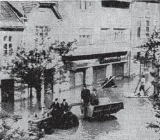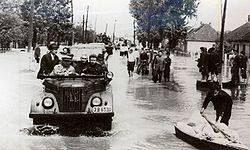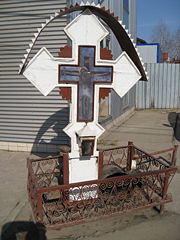
1970 floods in Romania
Encyclopedia


Carpathian Mountains
The Carpathian Mountains or Carpathians are a range of mountains forming an arc roughly long across Central and Eastern Europe, making them the second-longest mountain range in Europe...
, were the worst in modern Romania
Romania
Romania is a country located at the crossroads of Central and Southeastern Europe, on the Lower Danube, within and outside the Carpathian arch, bordering on the Black Sea...
n history in loss of life, and caused the most damage up to the 2006 floods
2006 European floods
From February to April 2006 many rivers across Europe, especially the Elbe and Danube, swelled due to heavy rain and melting snow and rose to record levels...
: at least $
United States dollar
The United States dollar , also referred to as the American dollar, is the official currency of the United States of America. It is divided into 100 smaller units called cents or pennies....
500 million; perhaps over $1 billion.
History
The floods began around May 12 and lasted into mid-June. 209 people were killed, 41,000 houses were damaged or totally destroyed (leaving at least 265,000 homeless), over a million arable acres were inundated, over 100,000 sheep, pigs, cows and chickens (including over 35,000 head of cattle) drowned, 146 factories were idled at least temporarily, and over 250 miles (402.3 km) of highway required repair. At least 240,000 people were evacuated, some repeatedly. 37 of Romania's then 39 countiesCounties of Romania
The 41 judeţe and the municipality of Bucharest comprise the official administrative divisions of Romania. They also represent the European Union' s NUTS-3 geocode statistical subdivision scheme of Romania.-Overview:...
were severely damaged, with 230 towns and villages hit in just the first twelve days, including Sighişoara
Sighisoara
Sighişoara is a city and municipality on the Târnava Mare River in Mureş County, Romania. Located in the historic region Transylvania, Sighişoara has a population of 27,706 ....
and Mediaş
Medias
Mediaș is the second largest city in Sibiu County, Transylvania, Romania.-Geographic location:Mediaș is located in the middle basin of Târnava Mare River, at 39 km from Sighișoara and 41 km from Blaj. The health resort Bazna, officially recognized for the first time in 1302, is...
, the women and children of which were evacuated to centres in hill villages while the men salvaged possessions. Airports, including those at Sibiu
Sibiu
Sibiu is a city in Transylvania, Romania with a population of 154,548. Located some 282 km north-west of Bucharest, the city straddles the Cibin River, a tributary of the river Olt...
and Satu Mare, were flooded and closed. Railway systems were damaged, and landslides blocked roads and carried away telegraph lines.
Broadly speaking, floodwaters moved from the northern and central regions toward the Danube lowlands in the south and east. The Prahova
Prahova River
The Prahova River is a river of Southern Romania, which rises from the Bucegi Mountains, in the Southern Carpathians and flows into the Ialomiţa...
, Târnava
Târnava River
The Târnava is a river in Romania. It is formed by the confluence of the Târnava Mare and Târnava Mică in the town of Blaj. The Târnava flows into the Mureş River after 28 km, near the town of Teiuş.- Etymology :...
, Olt
Olt River
The Olt River is a river in Romania. It is the longest river flowing exclusively through Romania. Its source is in the Hăşmaş Mountains of the eastern Carpathian Mountains, near the village Bălan. It flows through the Romanian counties Harghita, Covasna, Braşov, Sibiu, Vâlcea and Olt...
(threatening Râmnicu Vâlcea
Râmnicu Vâlcea
Râmnicu Vâlcea is the capital city of Vâlcea County, Romania .-Geography and climate:Râmnicu Vâlcea is situated in the central-south area of Romania...
and Slatina
Slatina, Romania
Slatina is the capital city of Olt county, Romania, on the river Olt.The city administers one village, Cireaşov.-History:The town of Slatina was first mentioned on January 20, 1368 in an official document issued by Vladislav I Vlaicu, Prince of Wallachia. The document stated that merchants from...
) and Tisza
Tisza
The Tisza or Tisa is one of the main rivers of Central Europe. It rises in Ukraine, and is formed near Rakhiv by the junction of headwaters White Tisa, whose source is in the Chornohora mountains and Black Tisa, which springs in the Gorgany range...
rivers were among those affected, as well as the Danube
Danube
The Danube is a river in the Central Europe and the Europe's second longest river after the Volga. It is classified as an international waterway....
(which rose up to 6½ ft above normal spring high-water levels, flooding docks and port installations in Turnu Severin
Drobeta-Turnu Severin
Drobeta-Turnu Severin is a city in Mehedinţi County, Oltenia, Romania, on the left bank of the Danube, below the Iron Gates.The city administers three villages: Dudaşu Schelei, Gura Văii, and Schela Cladovei...
), Prut
Prut
The Prut is a long river in Eastern Europe. In part of its course it forms the border between Romania and Moldova.-Overview:...
and Siret
Siret River
The Siret or Sireth is a river that rises from the Carpathians in the Northern Bukovina region of Ukraine, and flows southward into Romania for 470 km before it joins the Danube...
. As crests rolled onward, downstream localities knew to fear the worst: for instance, Galaţi
Galati
Galați is a city and municipality in Romania, the capital of Galați County. Located in the historical region of Moldavia, in the close vicinity of Brăila, Galați is the largest port and sea port on the Danube River and the second largest Romanian port....
and Brăila
Braila
Brăila is a city in Muntenia, eastern Romania, a port on the Danube and the capital of Brăila County, in the close vicinity of Galaţi.According to the 2002 Romanian census there were 216,292 people living within the city of Brăila, making it the 10th most populous city in Romania.-History:A...
knew by June 3 that floods from three weeks earlier would reach them on June 11, the question being if their dikes would hold. The neighbouring Soviet Union and Bulgaria were not nearly as threatened, as the Prut and Danube banks are steep and high on their shores. The floods also came in phases: for instance, the waters were just beginning to recede when on May 23-24 renewed heavy rain and snowfalls raised their level again.
Significant resources were mobilised to fight the waters and their effects. Medical teams toured most areas of the country warning people not to drink polluted water (many drinking water installations were destroyed) and inoculating all citizens aged 2 to 55 against typhoid fever
Typhoid fever
Typhoid fever, also known as Typhoid, is a common worldwide bacterial disease, transmitted by the ingestion of food or water contaminated with the feces of an infected person, which contain the bacterium Salmonella enterica, serovar Typhi...
. Thousands of soldiers and civilians worked around the clock to build miles of new dikes and reinforce old ones.
The floods had political ramifications as well. General Secretary Nicolae Ceauşescu
Nicolae Ceausescu
Nicolae Ceaușescu was a Romanian Communist politician. He was General Secretary of the Romanian Communist Party from 1965 to 1989, and as such was the country's second and last Communist leader...
took personal direction of some emergency measures in the Brăila and Galaţi areas, particularly sensitive because their heavy industry and grain-shipping centres are near the Danube, Prut and Siret, all three of which were swollen and which merge four miles (6 km) upstream from Galaţi. On May 22, wearing a black turtleneck sweater, workman's cloth cap and farmer's jacket, Ceauşescu and high Romanian Communist Party
Romanian Communist Party
The Romanian Communist Party was a communist political party in Romania. Successor to the Bolshevik wing of the Socialist Party of Romania, it gave ideological endorsement to communist revolution and the disestablishment of Greater Romania. The PCR was a minor and illegal grouping for much of the...
leaders spent hours superintending the completion of a five-mile (8 km)-long earth and timber dike at Brăila. In foreign policy, the floods offered him an opportunity to continue Romania's independent foreign policy, which sought to keep its distance from the Soviet Union
Soviet Union
The Soviet Union , officially the Union of Soviet Socialist Republics , was a constitutionally socialist state that existed in Eurasia between 1922 and 1991....
. While at the height of the floods, he made a sudden trip to Moscow
Moscow
Moscow is the capital, the most populous city, and the most populous federal subject of Russia. The city is a major political, economic, cultural, scientific, religious, financial, educational, and transportation centre of Russia and the continent...
, followed a week later by Prime Minister Ion Gheorghe Maurer
Ion Gheorghe Maurer
Ion Gheorghe Iosif Maurer was a Romanian communist politician and lawyer.-Biography:Born in Bucharest to a Saxon father and a Romanian mother of French origin, he completed studies in Law and became an attorney, defending in court members of the illegal leftist and Anti-fascist movements...
, this worried Romanians and Ceauşescu then toured the country, saying over and over in speeches to flood victims that his policy remained unchanged—national independence and sovereignty, noninterference in the internal affairs of other states, equality between governments and between Communist parties, and the right of each party to shape its own policies.
The provision of foreign aid also reflected this independent course. The single largest relief payment, the equivalent of $400,000, came from the People's Republic of China
People's Republic of China
China , officially the People's Republic of China , is the most populous country in the world, with over 1.3 billion citizens. Located in East Asia, the country covers approximately 9.6 million square kilometres...
, then embroiled in the Sino-Soviet split
Sino-Soviet split
In political science, the term Sino–Soviet split denotes the worsening of political and ideologic relations between the People's Republic of China and the Union of Soviet Socialist Republics during the Cold War...
. The first relief plane came from Israel
Israel
The State of Israel is a parliamentary republic located in the Middle East, along the eastern shore of the Mediterranean Sea...
; Romania was the only Eastern Bloc country to have relations with Israel at the time. Aid from the United States
United States
The United States of America is a federal constitutional republic comprising fifty states and a federal district...
and the Netherlands
Netherlands
The Netherlands is a constituent country of the Kingdom of the Netherlands, located mainly in North-West Europe and with several islands in the Caribbean. Mainland Netherlands borders the North Sea to the north and west, Belgium to the south, and Germany to the east, and shares maritime borders...
soon followed, but a week passed before the USSR sent a message and an offer of aid. Moreover, Western companies offered to repair or replace damaged industrial equipment they had furnished: the Galaţi iron and steel plant (Romania's largest) was built with Western expertise and equipment against Soviet opposition. Over a dozen countries, including France
France
The French Republic , The French Republic , The French Republic , (commonly known as France , is a unitary semi-presidential republic in Western Europe with several overseas territories and islands located on other continents and in the Indian, Pacific, and Atlantic oceans. Metropolitan France...
and Yugoslavia
Socialist Federal Republic of Yugoslavia
The Socialist Federal Republic of Yugoslavia was the Yugoslav state that existed from the abolition of the Yugoslav monarchy until it was dissolved in 1992 amid the Yugoslav Wars. It was a socialist state and a federation made up of six socialist republics: Bosnia and Herzegovina, Croatia,...
, gave aid. British
United Kingdom
The United Kingdom of Great Britain and Northern IrelandIn the United Kingdom and Dependencies, other languages have been officially recognised as legitimate autochthonous languages under the European Charter for Regional or Minority Languages...
aid organisations promised 50 tons of food, children's clothing and medicine, while West Germany
West Germany
West Germany is the common English, but not official, name for the Federal Republic of Germany or FRG in the period between its creation in May 1949 to German reunification on 3 October 1990....
sent a number of mobile water-purification units. A special fund was set up in Bucharest
Bucharest
Bucharest is the capital municipality, cultural, industrial, and financial centre of Romania. It is the largest city in Romania, located in the southeast of the country, at , and lies on the banks of the Dâmbovița River....
to assist flood victims; money poured in from factory groups throughout Romania. In one Bucharest institute, 100 donors a day gave blood, while scores of foreign diplomats gave clothing and household items.
Aftermath
Reflecting a drive for development and modernisation, the regime embarked upon a national land-improvement programme following the floods, covering drainage, irrigation, soil erosion, navigation, power, research and training in a comprehensive approach that departed from mere reliance upon control structures. Not only did Romania cope with the floods; it brought in specifically designed alleviative and preventive measures. The floods were mentioned in at least one literary work: Marin SorescuMarin Sorescu
- Biography :Born to a family of farmworkers in Bulzeşti, Dolj County, Sorescu graduated from the primary school in his home village. After that he went to the Buzesti Brothers High School in Craiova, after which he was transferred to the Predeal Military School. His final education was at the...
's 1976 play Matca ("The Matrix"). During the rains, a woman gives birth to her child while her father is dying in an adjacent room. As the waters close in on her, her sole thought is to raise the baby above her head in an effort to save it.
The main goal of building the Stânca-Costeşti Dam
Stânca-Costeşti Dam
The Stânca-Costeşti Dam is a dam on the Prut and a checkpoint between Moldova and Romania. The dam is located between Costeşti and Stânca .-History:...
, completed in 1978, was to protect villages down the Prut
Prut
The Prut is a long river in Eastern Europe. In part of its course it forms the border between Romania and Moldova.-Overview:...
river from floods.

